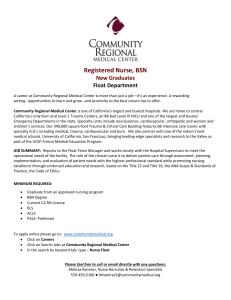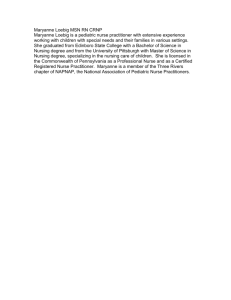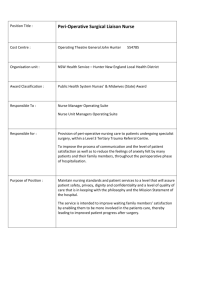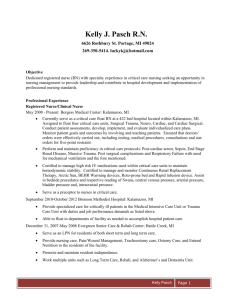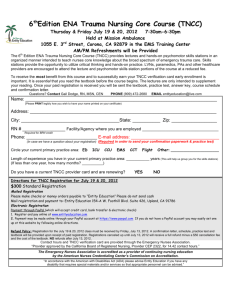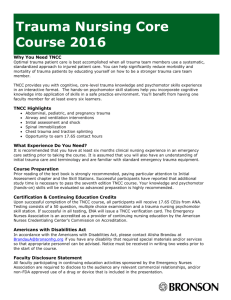TNCC 7th Edition: Practice Test
advertisement
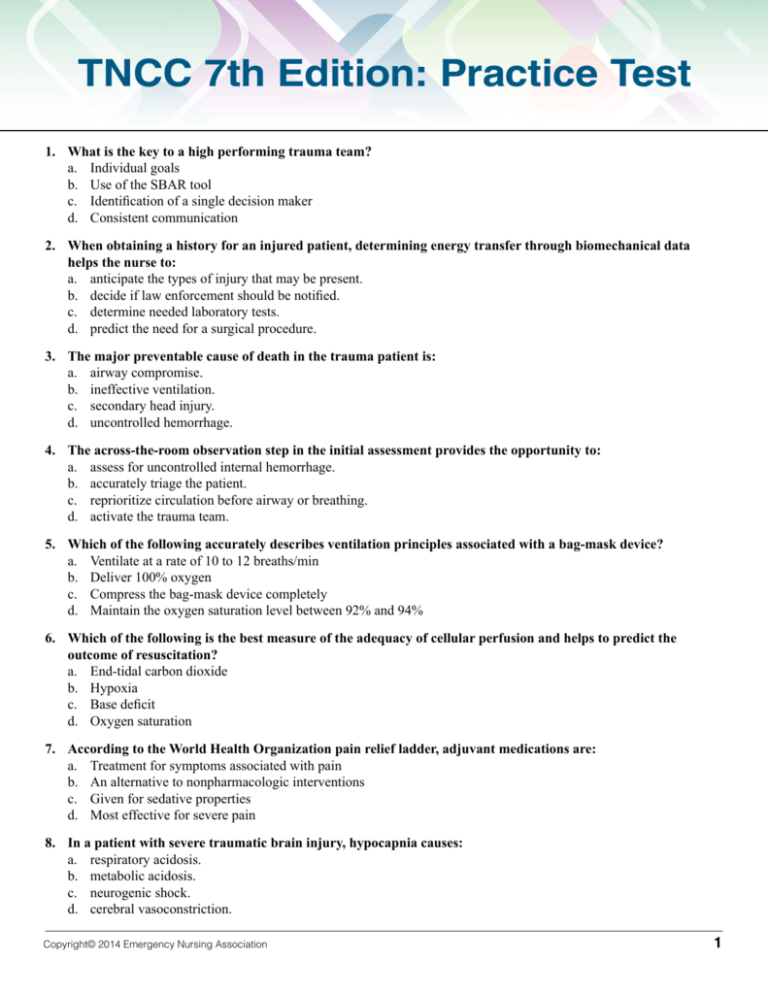
TNCC 7th Edition: Practice Test 1. What is the key to a high performing trauma team? a. Individual goals b. Use of the SBAR tool c. Identification of a single decision maker d. Consistent communication 2. When obtaining a history for an injured patient, determining energy transfer through biomechanical data helps the nurse to: a. anticipate the types of injury that may be present. b. decide if law enforcement should be notified. c. determine needed laboratory tests. d. predict the need for a surgical procedure. 3. The major preventable cause of death in the trauma patient is: a. airway compromise. b. ineffective ventilation. c. secondary head injury. d. uncontrolled hemorrhage. 4. The across-the-room observation step in the initial assessment provides the opportunity to: a. assess for uncontrolled internal hemorrhage. b. accurately triage the patient. c. reprioritize circulation before airway or breathing. d. activate the trauma team. 5. Which of the following accurately describes ventilation principles associated with a bag-mask device? a. Ventilate at a rate of 10 to 12 breaths/min b. Deliver 100% oxygen c. Compress the bag-mask device completely d. Maintain the oxygen saturation level between 92% and 94% 6. Which of the following is the best measure of the adequacy of cellular perfusion and helps to predict the outcome of resuscitation? a. End-tidal carbon dioxide b. Hypoxia c. Base deficit d. Oxygen saturation 7. According to the World Health Organization pain relief ladder, adjuvant medications are: a. Treatment for symptoms associated with pain b. An alternative to nonpharmacologic interventions c. Given for sedative properties d. Most effective for severe pain 8. In a patient with severe traumatic brain injury, hypocapnia causes: a. respiratory acidosis. b. metabolic acidosis. c. neurogenic shock. d. cerebral vasoconstriction. Copyright© 2014 Emergency Nursing Association 1 TNCC 7th Edition: Practice Test 9. A patient with a knife injury to the neck has an intact airway and is hemodynamically stable. He complains of difficulty swallowing and speaking. Further assessment is indicated next for which of the following conditions? a. Damage to the spinal cord b. An expanding pneumothorax c. Laceration of the carotid artery d. Injury to the thyroid gland 10. What is the appropriate technique to palpate the pelvis for stability? a. Apply gentle pressure over the iliac wings downward and laterally b. Apply gentle pressure over the iliac wings downward and medially c. Apply firm pressure over the iliac wings downward and laterally d. Apply firm pressure over the iliac wings downward and medially 11. A patient with a spinal cord injury at C5 is being cared for in the emergency department while awaiting transport to a trauma center. Which of the following represents the highest priority for ongoing assessment? a. Monitor respiratory status b. Administer balanced resuscitation fluid c. Perform serial assessments of neurologic function d. Observe for signs of distributive shock 12. What is the first step to stop a hemorrhage associated with an amputated extremity? a. Elevate the extremity to the level of the heart b. Initiate direct pressure c. Apply a tourniquet d. Splint the residual limb 13. Treatment for frostbite includes: a. warm the affected part slowly over 30 to 60 minutes b. use gentle friction to improve circulation. c. administer aspirin. d. leave blisters intact. 14. A 30-week pregnant trauma patient’s vital signs include a blood pressure of 94/72 mm Hg and a heart rate of 108 beats/min. Fetal heart tones are 124 beats/min. The emergency nurse interprets the patient’s hemodynamic findings as an indication of which of the following? a. Decompensated shock b. Normal vital signs in pregnancy c. Placental abruption d. Supine hypotension syndrome 15. While performing an assessment on a 13 month-old involved in a motor vehicle collision, the nurse identifies which of the following findings from the patient as a potential sign of mental status changes? a. Sunken fontanel b. Crying, but consolable c. Hyperglycemia d. Cooperation with the assessment Copyright© 2014 Emergency Nursing Association 2 TNCC 7th Edition: Practice Test 16. What is the best position to maintain an open airway in the bariatric patient? a. Prone b. Supine c. Reverse Trendelenburg d. Right lateral recumbent 17. The nurse is obtaining a history for a patient who presents following sexual assault. This history is completed using which of the following techniques? a. Bring the family in to the interview room b. Use direct quotes to record information c. Assure law enforcement and social services wait until the nursing history is completed d. Provide food and drink before creating a rapport 18. A trauma nurse cared for a child with devastating burns 2 weeks ago. She called in sick for a couple of days and is now back working on the team. Which of the following behaviors would indicate this nurse is coping well? a. She is talking about taking the emergency nursing certification examination b. She keeps requesting to be assigned to the walk-in/ambulatory area c. She is impatient and snaps at coworkers d. She is thinking about transferring out of the emergency department 19. Following a bomb explosion, fragmentation injuries from the bomb or objects in the environment are examples of which phase of injury? a. Primary b. Secondary c. Tertiary d. Quaternary 20. A patient is diagnosed with small subdural hematoma with a history of a trip and fall in which he hit his head on the sink two weeks ago. He is waiting for an inpatient bed. The nursing shift report indicates that he did not sleep last night and has been very anxious. As the nurse begins an assessment, he vomits and states he couldn’t sleep because a young child kept coming in his room during the night. What is a likely cause for these signs and symptoms? a. Increased intracranial pressure b. Alcohol withdrawal c. Rhabdomyolysis d. Pulmonary embolus Copyright© 2014 Emergency Nursing Association 3
